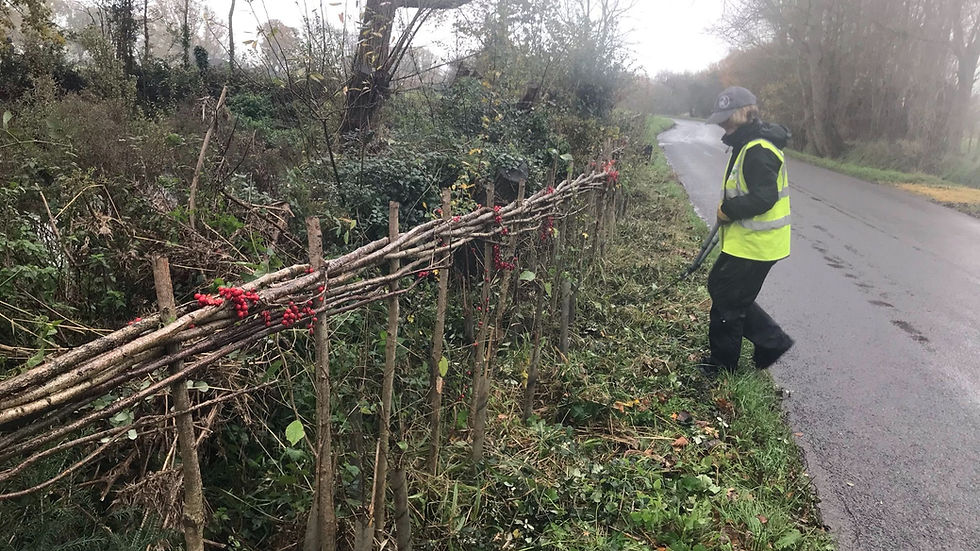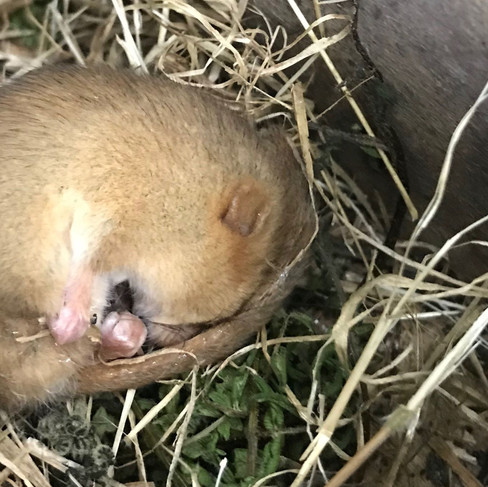Hedge Clipping 9
- Jane Reeve

- Jan 11, 2024
- 3 min read
Southern Water Biodiversity Grant funded - Hedging Our Future Project
In December we continued with our planting programme and planted 1203 trees totalling 310 metres of new hedges. We still need more help so please do join us in January to continue with the planting as the season will soon be finished.
Climbers in hedges – a different food source.
Climbing plants are an important part of a hedge and something not always seen in woody copses or woods. They can bind the hedge trees together and offer a different food source to birds, small mammals and insects. They can also act as a highways within the hedge allowing small creatures to navigate their way through the dense foliage.
The most common climbers seen in this area are bramble (Rubus fruticosus), honeysuckle (Lonicera periclymenum), clematis, also known as Traveller's Joy and Old Man's Beard (Clematis vitalba), Black bryony (Dioscorea communis) and White bryony (Bryonia dioica).
These climbers add colour, food opportunities, and nesting material for different species. The black bryony berries look like christmas garlands as they create strings of berries in winter blackbirds can be seen feasting on them in late winter. The clematis seeds are very visible in late summer covering hedgerows with a fluffy down and are used by goldfinches who feed on them.
Why is bramble so important when it is so annoyingly successful? I frequently get asked about the value of bramble as our volunteers spend a lot of time cutting it back. It is a native species, a very successful one in this area, where the high nutrient rich soil and mild weather means that is grows well. While there are species that eat it, especially the tender shoots in the spring - water voles, deer, rabbits and small mammals, we are missing the large herbivores in our ecosystems now that would have made a real dent - the bison, elk and wild goats. Bramble offers a great refuge for many birds as the thick impenetrable growth protects nests from predators like magpies and squirrels. The flowers are a food source for insects, and we all love the fruit, so have to put up with the odd scratch and think of the greater good!
A species that is massively under recorded on the peninsula is the Hazel dormouse (Muscardinus avellanarius). It has been believed in the past that these lovely small mammals could only be found in Ancient woodland but they seem to be more adaptable to other habitats than first thought. Dense scrub area along motorways, dense bramble thickets on Portland Bill and good dense hedgerows have been found to house populations of dormice. So they maybe on the peninsula but a comprehensive survey has not been carried out. They are notoriously shy and difficult to survey for as they are not that keen on dormice boxes!
Dormice are particularly reliant on climbers, especially clematis and honeysuckle. This small mammals spends most of its time in the tree canopy and only comes down to ground level to hibernate in the winter. They use the climbers to navigate their way between different trees and levels. Dormice are not leaf eaters as they are unable to digest the cellulose, therefore, they eat flowers, nectar, pollen, fruit, insect larvae and adults. Honeysuckle has the added use of the stems being stripped and the fibrous material used to create maternity nest balls. Dormice can live in good quality, dense and connected hedgerows, especially if they link up woodland areas.
Honeysuckle has a long flowering period and even into November it may still offer food for wasps, butterflies and moths. It is a key food plant for the hummingbird hawk moth which is a delight to watch.
Two other climbers that are worth noting are hedge bindweed (Calystegia sepium) and hops (Humulus lupulus). I can hear gardeners flinch as I mention the bindweed and it can be very difficult to manage in a domestic garden setting. It can also be an issue when managing sites for wildlife as it can suppress other plants and tent trees potentially reducing floral biodiversity. However, the flowers are very nectar rich and a great source of food for many insects so we need to look upon it more kindly! It does seem to be very vigorous in this area perhaps due to our warm and wet climate.
We are increasingly seeing hops on our sites and while attractive in autumn with their pretty flowers, it can be very invasive. It has prickly fibrous rope like stems and they seek to grow up through tree branches and over hedges. They can be quite weighty and cover all foliage which can result in a loss of other plant species. We tend to cut it back back but it persists and it is an ongoing task.
All these climbers are an important aspect of hedges that you may see as you travel around locally. They will be most obvious in spring and summer when they flower and then in autumn when some may fruit.
















Comments